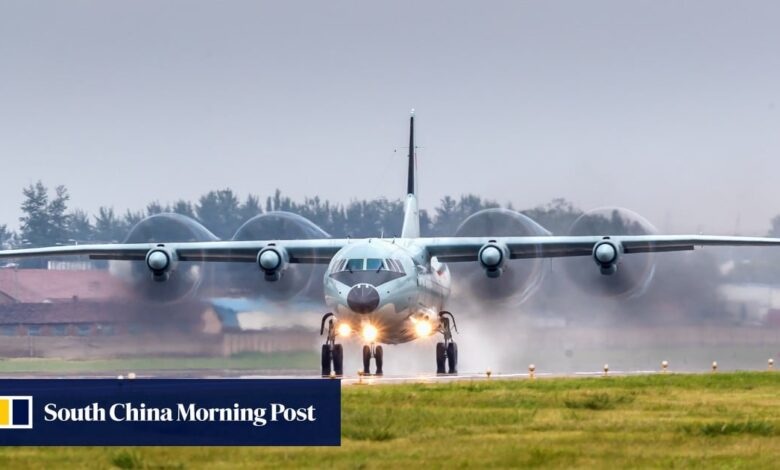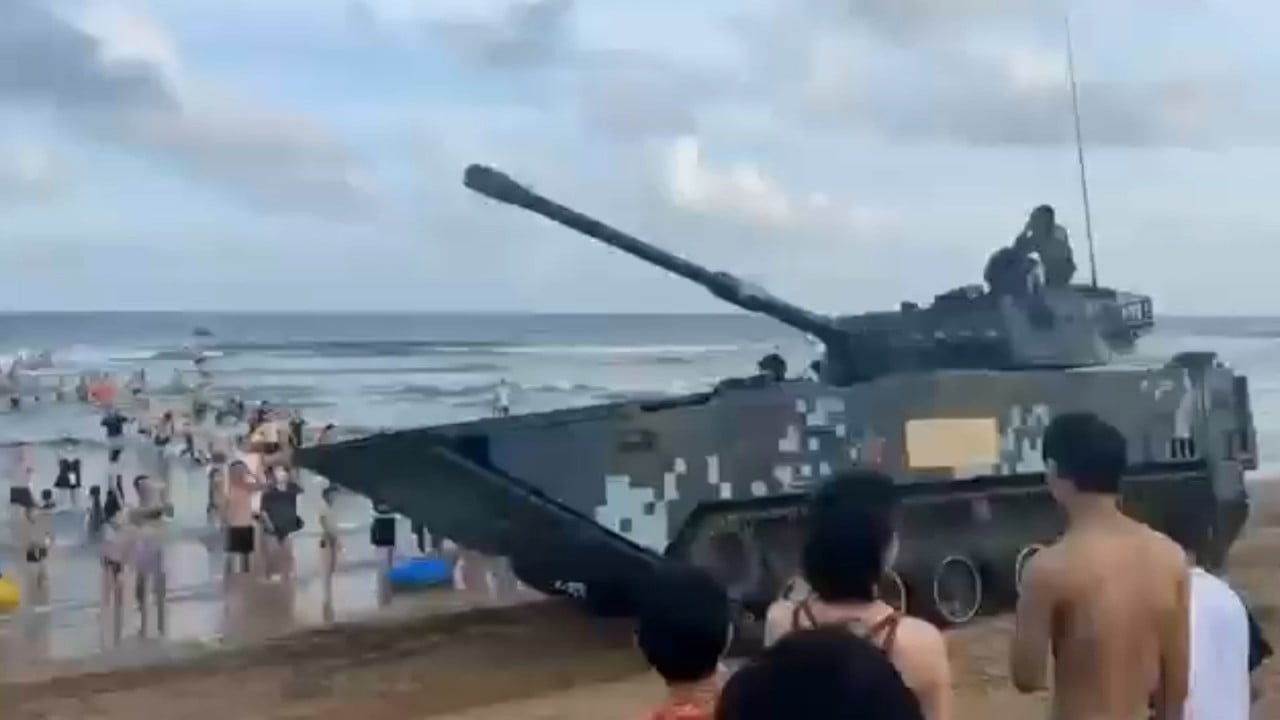Alarm in Taiwan as online map appears to show PLA ‘Trojan horse’ flight

The ministry’s statement was referring to PLA activities over the previous week involving aircraft and ground troops at Dacheng Bay in Fujian province.
The exercises appeared to be a series of amphibious drills involving fighters, drones, bombers and other aircraft, as well as warships and were in addition to the PLA’s regular fly-bys or crossovers of the median line to areas close to the island, the ministry said.
According to the online reports, the Y-9 briefly followed Flight CX366 on the M503 route before diving directly below the civilian aeroplane and flying in a vertical position beneath it, just kilometres from the de facto median line in the Taiwan Strait.
The screenshots appear to show the military transport craft disappearing from the real-time map for about 10 minutes and reappearing after the passenger plane heads north to Shanghai Pudong airport.
When approached for comment, Cathay Pacific said: “Flight CX366 from Hong Kong to Shanghai Pudong on 24 September operated normally to its destination.”
Retired Taiwanese air force lieutenant general Chang Yen-ting described the manoeuvre as a “Trojan horse” that would leave just one light dot on radar screens.
“If three or five communist warplanes flew in formations in a vertical up-and-down position, using civilian airliners as cover, we might be caught in a surprise attack as the warplanes would be able to fly to Taipei and other major cities in just five to 10 minutes,” he said.
“It would greatly squeeze our response time if the communist warplanes stage a ‘Trojan Horse’ type of surprise air attack by way of the M503 flight route under the cover of civilian aeroplanes.”
Taiwanese presidential hopeful William Lai stresses cross-strait status quo
Taiwanese presidential hopeful William Lai stresses cross-strait status quo
Chang said the PLA might try to normalise such activities, as it did in regularly sending warplanes into Taiwan’s air defence identification zone and crossing the median line, an unofficial demarcation that was previously respected.
“There is a strong need for the military to remain highly cautious and strengthen the training of its control tower officers so that they can identify overlapping objects quickly,” he said.
M503 runs from south to north and is just 7.8km (4.8 miles) from the median line at its closest point.
The route was launched by Beijing in 2018 with the approval of the International Civil Aviation Organisation, despite repeated protests from Taipei over its proximity to the island’s flight information region.
A Taiwanese military official, who declined to be identified, said it would be difficult for a PLA warplane to hide under a civilian plane without being detected.
“Basically, a passenger aeroplane is equipped with a traffic collision avoidance system designed to warn the pilot of the presence of another plane about 1,000 metres (3,280 miles) nearby. The system will flash warnings if another plane is flying below vertically.”
The official said the ground control centre would also be alerted and would only have to remove the light dot on the radar screen to find the second dot underneath.
But he conceded that the relatively poor resolution of conventional air defence radars – compared to those of anti-air missile defence systems – could lead to the manoeuvre being missed by control towers.
KMT’s Hou pledges strong military and talks for Taiwan to keep Beijing at bay
KMT’s Hou pledges strong military and talks for Taiwan to keep Beijing at bay
Su Tzu-yun, a senior analyst at the Institute for National Defence and Security Research, a government think tank in Taipei, said he would not rule out the possibility of the PLA using third-party planes as a shield to initiate a surprise attack, but it would not be an easy task.
“There was a previous example, in which F-16 pilots of the Israeli air force were reported to have used an II-20 reconnaissance plane – which had a bigger reflective surface than the F-16 – as a shield to cover their flight path,” he said.
Su was referring to accusations by Moscow in September 2018 that Israel used the tactic to carry out missile strikes against targets in Syria, leading to the accidental shooting down of a Russian plane by a Syrian missile. Tel Aviv denied the charge, saying that Syria was to blame for the incident.
Beijing – which has vowed to bring Taiwan under its control, by force if necessary – has been intensifying its military operations around the island since then US speaker Nancy Pelosi’s visit in August last year.
The US, along with most countries, does not recognise Taiwan as an independent state but is opposed to any unilateral change to the status quo. Beijing regarded Pelosi’s visit to the island as a violation of its sovereignty and a breach of Washington’s one-China policy.
Security analyst Chieh Chung from the National Policy Foundation, a think tank affiliated with Taiwan’s opposition Kuomintang party, is concerned about the risks posed by the increasing number of PLA warplanes flying parallel to the median line since last month.
“The [Taiwanese] military has set up four flight restriction zones east of the median line, with R8, R9, R11 and R5 extending from north to south as its special training air space [which] our air force also uses to monitor and respond to PLA air activities nearby,” he said.
PLA sorties force Taiwan’s military fuel budget up 55 per cent to US$344 million
PLA sorties force Taiwan’s military fuel budget up 55 per cent to US$344 million
The zones designated as R9 and R11 are closest to Taiwan and must be reached swiftly by the island’s patrolling military planes if PLA sorties cross the median line, Chieh said.
“By frequently flying along the median line and flying close to our flight restriction zones, the PLA might try to squeeze into the airspace of our restricted zones, leaving our air force pilots little time to respond and exhausting them.”
Chieh warned that such actions would only increase the chances of unintended incidents.






